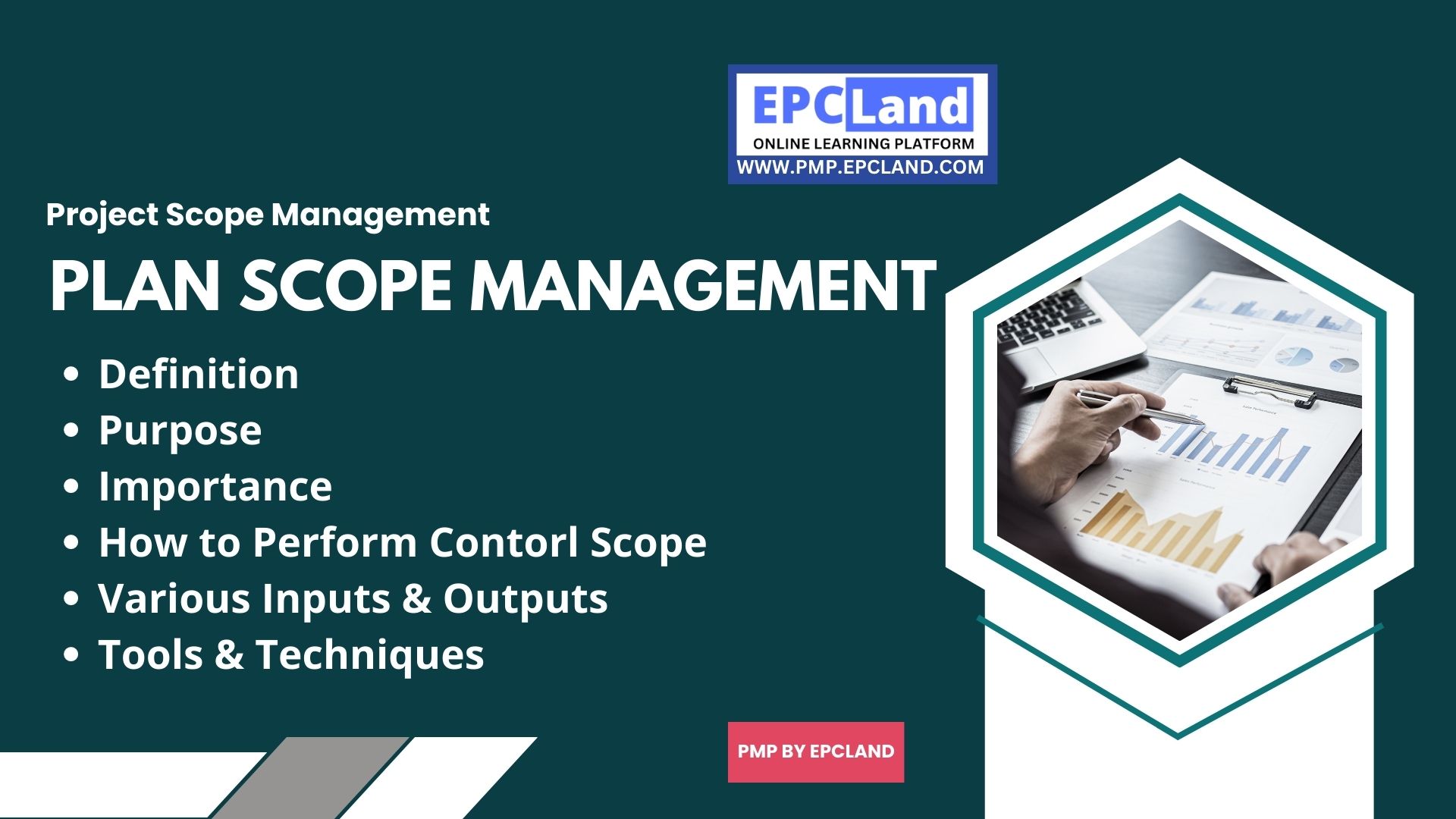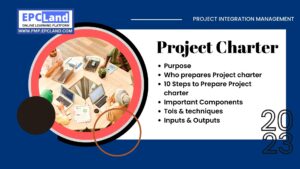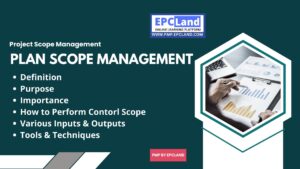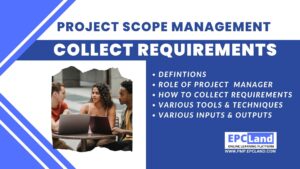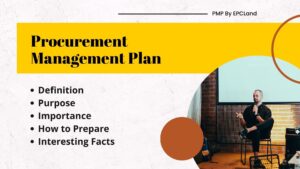Table of Contents
ToggleWhat is Plan Scope Management Process
Plan scope management is a process in project management that involves creating a detailed plan for defining, documenting, and controlling the scope of a project. The goal of plan scope management is to ensure that the project’s objectives and deliverables are clearly defined and that the project stays within its budget and schedule.
The plan scope management process includes several key steps, such as creating a work breakdown structure (WBS) to break down the project into smaller, manageable tasks, developing a scope statement that outlines the project’s objectives, deliverables, and requirements, and creating a scope change control system to document and track any changes to the project’s scope.
Additionally, plan scope management also includes creating a project charter that defines the project’s objectives, stakeholders, and high-level requirements, and using tools such as the requirements traceability matrix to trace the relationship between requirements and deliverables.
Overall, the plan scope management process is crucial for ensuring the project is executed as intended and that all the deliverables are met within the scope, time and budget constraints.
Attempt Quiz-1 on Plan Scope Management Process

Time's up
What is the Purpose of Plan Scope Management Process
The purpose of the plan scope management process in project scope management is to establish a clear and detailed plan for defining, documenting, and controlling the scope of a project. The main goals of this process are to:
- Define the project’s objectives, deliverables, and requirements: By clearly defining the project’s objectives and deliverables, the plan scope management process helps to ensure that the project stays on track and that all stakeholders are aware of what is expected from the project.
- Create a framework for the project: The plan scope management process helps to create a framework for the project by breaking it down into smaller, more manageable tasks, and by establishing the processes and procedures that will be used to define, document, and control the scope of the project.
- Ensure that the project stays within budget and schedule constraints: By establishing a scope change control system, the plan scope management process helps to ensure that the project stays within budget and schedule constraints, and that any changes to the scope are properly documented and tracked.
- Facilitate communication and collaboration among stakeholders: The plan scope management process helps to facilitate communication and collaboration among stakeholders by clearly defining the project’s objectives, deliverables, and requirements, and by establishing a scope change control system that ensures that all stakeholders are aware of any changes to the scope.
- Ensure that all requirements are met: The plan scope management process helps to ensure that all requirements are met by creating a requirements traceability matrix that traces the relationship between requirements and deliverables.
Overall, the plan scope management process is a crucial step in project scope management, as it helps to establish a clear and detailed plan for defining, documenting, and controlling the scope of a project, and ensures that the project stays on track and within budget and schedule constraints
8 important Steps to perform the Plan Scope Management Process
Plan scope management is performed through a series of steps:
- Define the project scope: This step involves identifying the project’s objectives, deliverables, and requirements, and creating a scope statement that outlines these elements.
- Create the work breakdown structure (WBS): The WBS is a hierarchical decomposition of the project into smaller, more manageable tasks. It helps to define the project’s deliverables and objectives.
- Develop the scope management plan: This step involves creating a document that outlines the processes and procedures that will be used to define, document, and control the scope of the project. This plan should include information about how changes to the scope will be managed, how the scope will be verified, and how the scope will be controlled.
- Identify the requirements: This step involves identifying the specific requirements for the project, such as functional and non-functional requirements.
- Create the requirements traceability matrix: This tool is used to trace the relationship between requirements and deliverables, and helps to ensure that all requirements are met.
- Obtain formal sign-off: This step involves obtaining formal approval from stakeholders for the project scope, including the scope statement, work breakdown structure, and requirements.
- Control the scope: Once the project is underway, it is important to regularly review and update the project scope as needed to ensure that the project stays on track and within budget and schedule constraints. The scope change control system should be used to document and track any changes to the scope.
- Verify the scope: The scope verification process is used to ensure that the project’s deliverables meet the requirements outlined in the scope statement.
Throughout these steps, it’s important to work closely with stakeholders and team members to ensure that the project scope is clearly defined and meets the needs of the organization.
Tools & Techniques for Plan Scope Management
There are several tools and techniques that can be used for plan scope management, including:
- Work breakdown structure (WBS): This tool is used to break down a project into smaller, more manageable tasks.
- Scope statement: This document outlines the project’s objectives, deliverables, and requirements.
- Scope change control system: This system is used to document and track any changes to the project’s scope.
- Requirements traceability matrix: This tool is used to trace the relationship between requirements and deliverables.
- Project charter: This document defines the project’s objectives, stakeholders, and high-level requirements.
- Scope verification: This technique is used to ensure that the project’s deliverables meet the requirements outlined in the scope statement.
- Scope control: This technique is used to ensure that changes to the project’s scope are approved and managed properly.
- Project Management Software: This software can help to manage all the project’s tasks and deliverables, and also allows real-time collaboration among team members.
These are some of the most commonly used tools and techniques for plan scope management, but the specific tools and techniques used will depend on the project and the organization.
Inputs and Outputs of the plan scope management process
The inputs and outputs of the plan scope management process are as follows:
Inputs for the Plan Scope Management Process
- Project charter: This document defines the project’s objectives, stakeholders, and high-level requirements, and is used to guide the creation of the scope management plan.
- Requirements documentation: This includes any documentation that outlines the specific requirements for the project, such as functional and non-functional requirements.
- Enterprise environmental factors: This includes any external factors that may impact the project, such as organizational policies, standards, and procedures.
- Organizational process assets: This includes any internal resources or assets that the organization can use to support the project, such as templates, processes, and procedures.
Outputs for Plan Scope Management Process
- Scope management plan: This document outlines the processes and procedures that will be used to define, document, and control the scope of the project.
- Work breakdown structure (WBS): This tool is used to break down the project into smaller, more manageable tasks, and helps to define the project’s deliverables and objectives.
- Scope statement: This document outlines the project’s objectives, deliverables, and requirements, and is used to guide the execution of the project.
- Requirements traceability matrix: This tool is used to trace the relationship between requirements and deliverables, and helps to ensure that all requirements are met.
- Project documents updates: Any project documents that need to be updated as a result of the plan scope management process, such as the project charter, requirements documentation, and project management plan.
Attempt Quiz-2 on Plan Scope Management Process

Time's up
Final Take Aways from Plan Scope Management Process
These are the key outputs, inputs and process of plan scope management, and helps in creating a framework for the project to be executed, and also helps in controlling the scope and ensuring all the deliverables are met.
FAQs on "Plan Scope Management" in Project Scope Management
What is Plan Scope Management in Project Management?
Plan Scope Management refers to the processes and techniques used to define, plan, monitor, and control the scope of a project. It involves creating a detailed plan for the project scope, including the objectives, deliverables, and timeline.
What are the steps involved in Plan Scope Management?
The steps involved in Plan Scope Management are:
- Defining the project scope
- Creating a scope management plan
- Determining project deliverables and objectives
- Developing a Work Breakdown Structure (WBS)
- Obtaining project stakeholders’ approval for the project scope
What is the purpose of Plan Scope Management?
The purpose of Plan Scope Management is to ensure that the project is well defined, and its objectives and deliverables are clear to all stakeholders. This helps in avoiding scope creep, reducing risks, and improving the chances of project success.
What is the difference between Project Scope and Project Management Plan?
Project Scope refers to the specific objectives and deliverables of a project, while the Project Management Plan includes all aspects of project management, including the scope, schedule, cost, quality, resources, communications, risk management, and procurement.
What is a Work Breakdown Structure (WBS) in Plan Scope Management?
A Work Breakdown Structure (WBS) is a hierarchical decomposition of the project into smaller, more manageable components. It helps in breaking down a large project into smaller tasks and defining the scope of each task.
What is scope creep in Plan Scope Management?
Scope creep refers to the uncontrolled changes or growth in a project’s scope, often resulting from poor project planning and management. It can lead to delays, cost overruns, and project failure.
Similar articles on Project Scope Management
Lorem ipsum dolor sit amet, consectetur adipiscing elit. Ut elit tellus, luctus nec ullamcorper mattis, pulvinar dapibus leo.
Add Your Heading Text Here
Lorem ipsum dolor sit amet, consectetur adipiscing elit. Ut elit tellus, luctus nec ullamcorper mattis, pulvinar dapibus leo.
Add Your Heading Text Here
Lorem ipsum dolor sit amet, consectetur adipiscing elit. Ut elit tellus, luctus nec ullamcorper mattis, pulvinar dapibus leo.
Add Your Heading Text Here
Lorem ipsum dolor sit amet, consectetur adipiscing elit. Ut elit tellus, luctus nec ullamcorper mattis, pulvinar dapibus leo.
